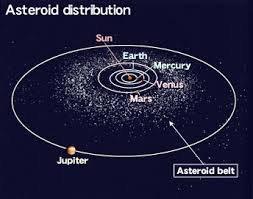Overview
The main asteroid belt is in the area between the planets Mars and Jupiter, although asteroids exist in most other parts of the Solar System. Scientists believe that asteroids in the asteroid belt formed from shattered remnants of protoplanets when the planetary disk started to cool. Many different types of asteroids have been observed, with sizes that range from dwarf planets such as Ceres, Vesta, Pallas, and Hygeia to grains of dust.
Asteroids
The main asteroid belt is located in a region of space 300 million to 600 million km from the sun, between the orbits of Mars and Jupiter. The largest asteroid Ceres, as well as many others, were observed by astronomers in the 19th century. They can be differentiated from stars on photographs because they appear to move and change position, while stars do not. However, they are so small that their movement is very subtle and difficult to detect. Scientists group asteroids by their geological composition, as shown on spectroscopic measurements. C-type asteroids are the most common and contain carbon compounds and chondrites, S-type are silicate rich, and M-type are metallic, mostly nickel-iron compounds. They are widely separated in space, so that if all the asteroids in the asteroid belt were collapsed into one body, that planet would be smaller than the Moon. Much of the information about asteroids comes from flyby missions such as Galileo, Hayabusa, Dawn, and Rosetta, which sent back pictures from space as they traveled to outer planets.
Formation
Scientists believe that the Solar System formed about 4.6 billion years ago from the disc of dust and gas that surrounded the newborn star. Gravitational attraction from the huge planet Jupiter prevented planetesimals close to it from gathering to form one huge planet. Instead, fragments collided and broke apart into irregularly-shaped rocks with orbits of their own. A few asteroids even have satellites of their own.
Dwarf Planets and Large Asteroids
The first asteroid to be observed, named Ceres, has a diameter of about 950 km. It is different from most other asteroids, because it is spherical, has a rocky inner core, an icy mantle, and a thin, light crust. It was classified as a dwarf planet in 2006. Vesta has a diameter of about 525 km, with a cratered surface over an iron-nickel core and a basaltic mantle. Pallas is less dense than Vesta but about the same size, and appears to be mostly silicate. Hygeia is oblong, with a diameter of about 430 km. It is the largest C-type asteroid.
Asteroids, Comets, and Meteors
Asteroids are similar to comets and meteors. The head of a comet consists of rocks and ice. Asteroids that orbit the sun closer to Jupiter and the outer planets either contain ice or once contained ice. Meteors, and the meteorites that strike the surface of a planet, tend to have similar chemical composition to C-type asteroids.
Interested in science tutoring services? Learn more about how we are assisting thousands of students each academic year.
SchoolTutoring Academy is the premier educational services company for K-12 and college students. We offer tutoring programs for students in K-12, AP classes, and college. To learn more about how we help parents and students in Billings, MT: visit Tutoring in Billings, MT




